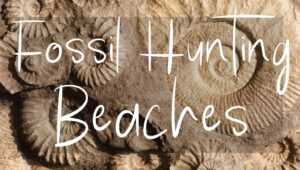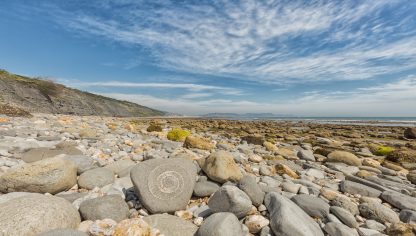Some posts on this site contain affiliate links. If you book or buy something through these links, I earn a small commission (at no extra cost to you). Take a look at my privacy policy for more information.
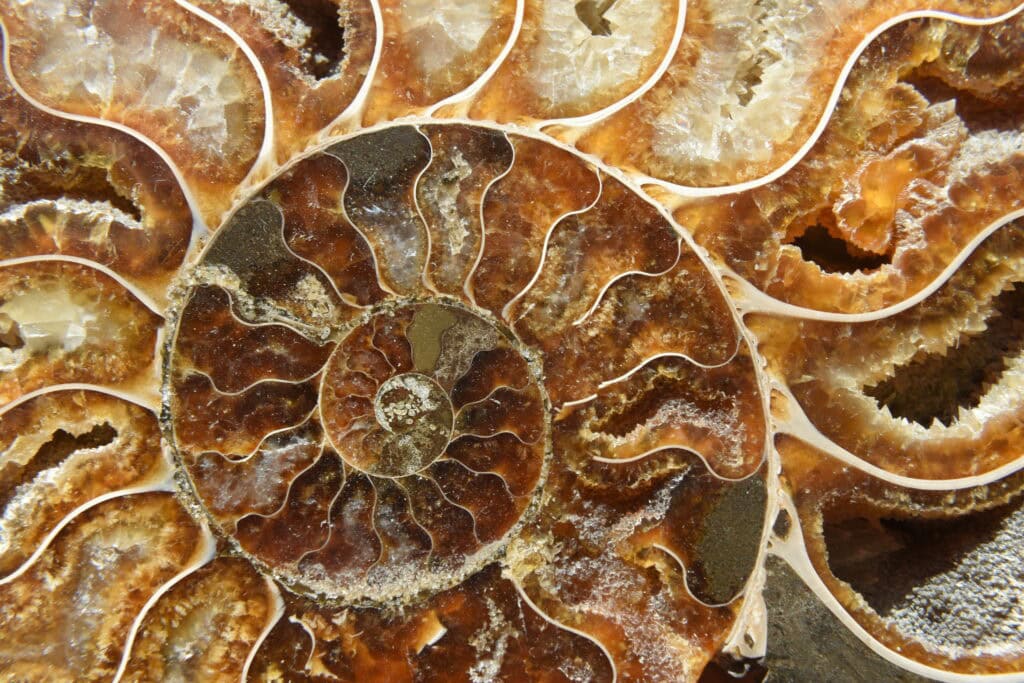
Everything you need to know about fossil hunting in Dorset – tips, what to look for, and where to go…
Dorset’s Jurassic Coast is famous for fossils! This 95-mile stretch of coastline was formed during the Triassic, Jurassic and Cretaceous periods, and the rocks here are packed with fossils from those times (particularly the latter two). Coastal erosion and mudslides mean new fossils are constantly being unearthed, and new discoveries are constantly being made.
This is our beginner’s guide to fossil hunting along the coastline. It’s intended for amateurs only; you shouldn’t need any tools or training. These are just great places to see fossils – from dinosaur footprints in an old quarry to beaches where you’re almost guaranteed to spot a few as you’re walking along! Happy hunting…
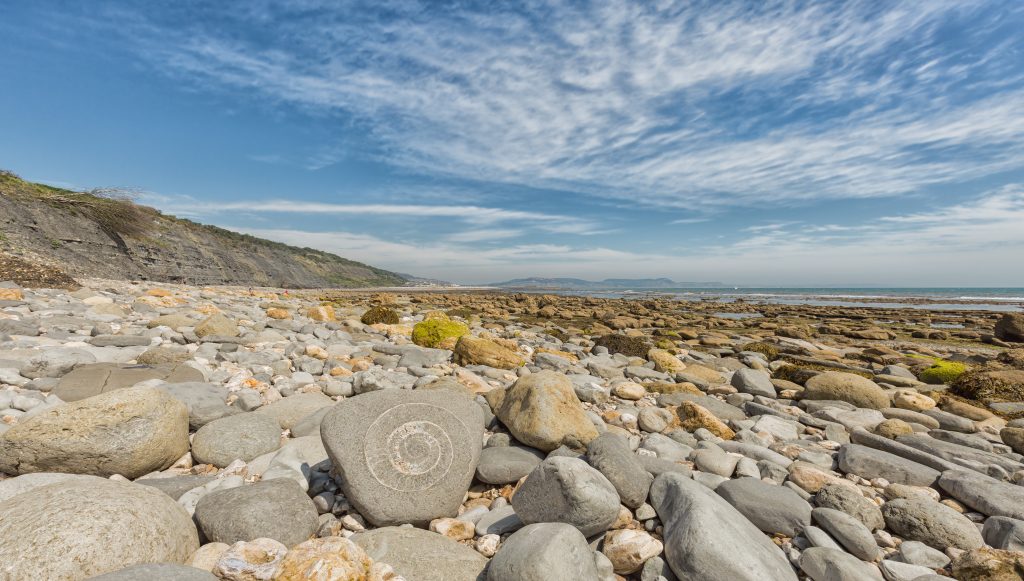
Fossil Hunting Tips & Safety Advice
The best place to look for fossils (and the safest place for beginners) is along the foreshore: the bit of the beach that’s exposed at low tide. The best time to look for them is when the tide starts going out.
Winter is usually the best time to find fossils, particularly after storms and bad weather. However, you can still find them in summer – and there are many fixed in larger rocks which can be seen all year round.
No digging or tools: Most beaches do not permit digging in the cliffs, and you usually have to seek permission before using tools like hammers or chisels, so always check the local rules before visiting a new place. The UK Fossil Network has an extensive guide which gives rules, tips, and safety advice for all locations.
Safety Tips
- Always check tide times. Some beaches are cut off at high tide, so always be aware of the tide times before setting out.
- Don’t dig in the cliffs. Digging can trigger rockfalls and is not safe unless you know what you’re doing. It is also not permitted on many beaches.
- Stay away from the base of cliffs and NEVER climb the cliffs. Rockfalls and mudslides are common, especially after bad weather. Stick to the foreshore for safety – and always steer well clear of any recent rockfalls.
- Pay attention to any warning signs. They’re there for you’re safety!
- Always follow the Fossil Hunting Code.
Where to See Fossils
Ammonite Pavement, Lyme Regis
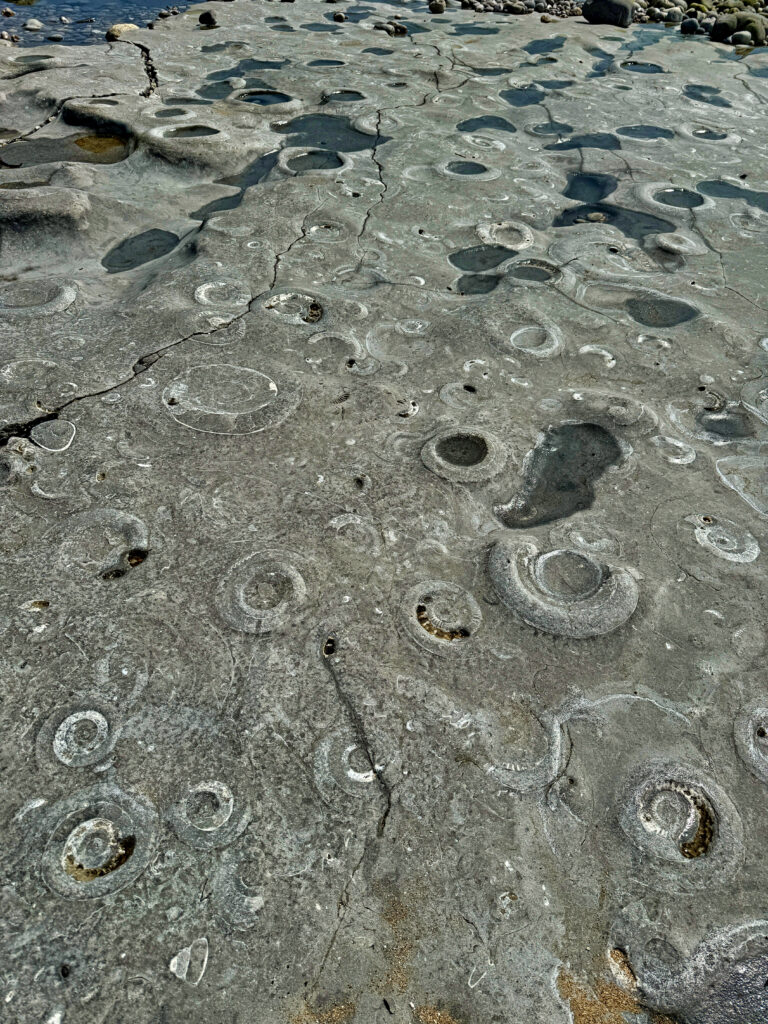
Also known as the Ammonite Graveyard, the Ammonite Pavement is found at the far western end of Monmouth Beach in Lyme Regis. At low tide, a rock ledge is exposed, which contains thousands of ammonite fossils dating from around 199 million years ago – some of which are up to 70 centimetres in diameter.
Getting There: The closest car park is Monmouth Beach Car Park. If it’s full, there’s a larger car park on Charmouth Road with a park & ride bus service in summer. Walk west along Monmouth Beach at low tide.
Fossil Forest, Lulworth Cove
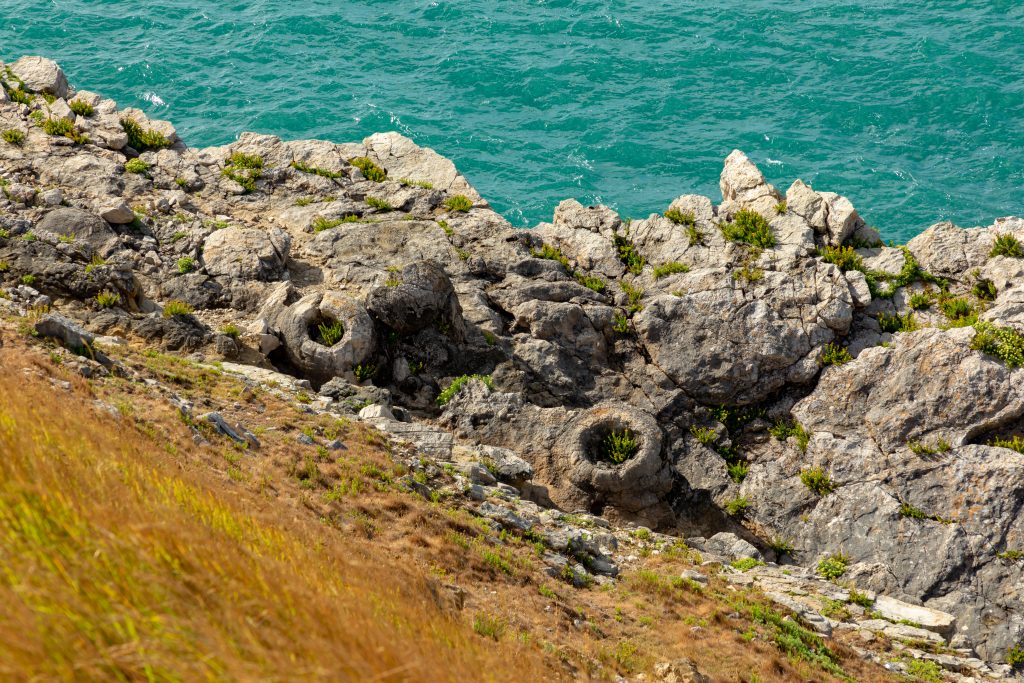
On the cliffs east of Lulworth Cove, you can visit a Fossil Forest. This is a cluster of fossilised tree stumps, trunks, and roots dating from the Jurassic period. The forest was formed around 150 million years ago, when a temporary drop in sea levels allowed plants and trees to grow in an area that had previously been underwater. When the climate changed, the water levels rose again, but the remains of the trees were preserved by layers of sediment.
Getting There: Park in Lulworth Cove Car Park (or take the bus to Lulworth, more info here). Walk along the beach and climb up to the coast path on the eastern side of the cove to reach the fossil forest. FYI: You can only visit the Fossil Forest when the surrounding army ranges are open, check the Range access times here.
Dinosaur Footprints, Spyway
Spyway is a wildlife-rich coastal landscape near Swanage on the Isle of Purbeck, owned and managed by the National Trust. Just off the Priest’s Way footpath is an enormous set of fossilised dinosaur footprints preserved in a layer of flat rock! There are over 100 tracks, thought to have been made by brachiosaurs around 145 million years ago. Read more here.
Getting There: Drive to Langton Matravers and park at Spyway National Trust Car Park on Durnford Drove (BH19 3HG). Follow the footpath leading south out of the car park (towards the coast), then turn right to follow Priest’s Way a short distance west to reach the footprints.
Beach Between Lyme Regis and Charmouth
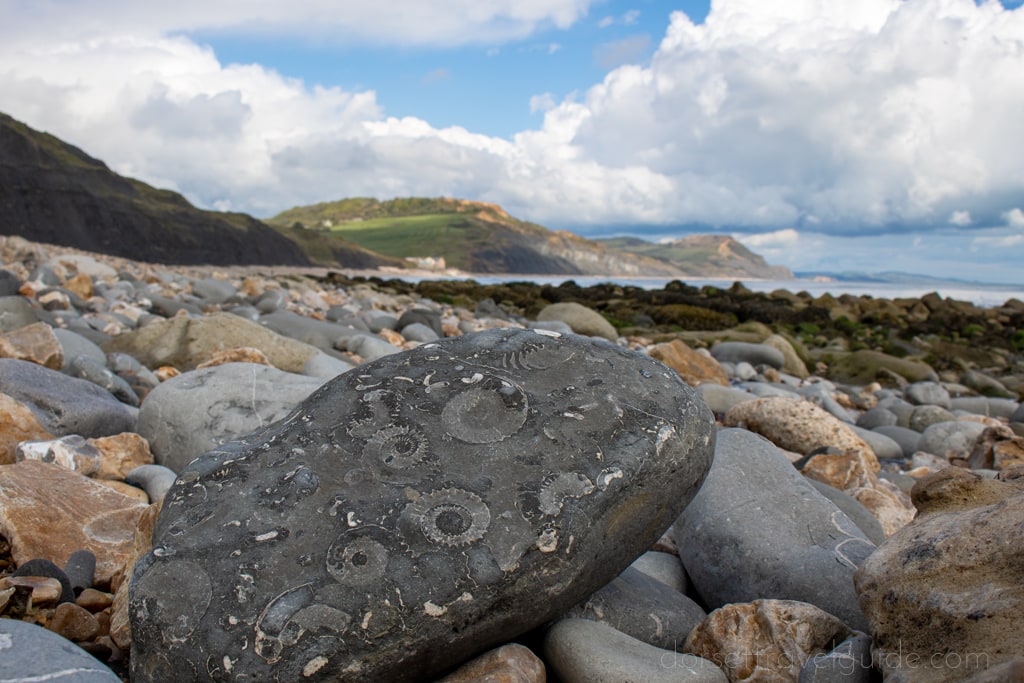
Starting at East Beach in Lyme Regis and stretching all the way to Charmouth, this stretch of beach is probably the best in all of Dorset for fossil finds. Lyme Regis is where the famous Victorian palaeontologist Mary Anning lived and made most of her discoveries. There are museums at either end with dozens of local finds on show, from dinosaur bones to fossilised poo (coprolites). Both museums also organise guided fossil walks along the beach.
Getting There: The Lyme Regis end of the beach is accessed from Charmouth Road Car Park (via 114 steps). There are toilets in the car park but no facilities at all on the beach. The Charmouth end of the beach is accessed from the Foreshore Car Park (directly behind the beach) and has toilets and a cafe close by. The middle section of this beach gets cut off at high tide, so always check tide times before heading out.
Best Dorset Beaches for Fossils
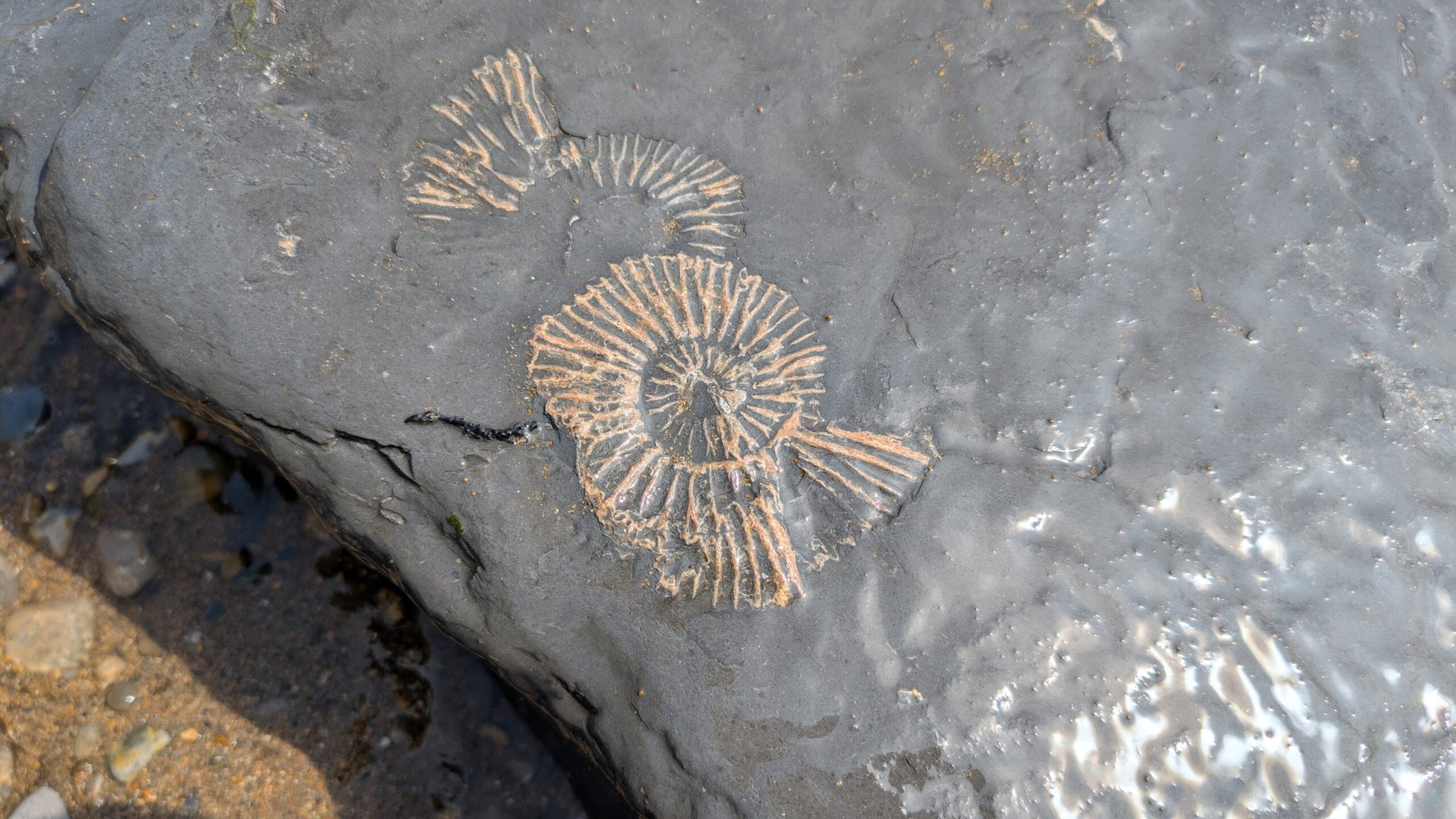
READ MORE: Best Fossil Beaches in Dorset (Complete Guide)
- East Beach (Back Beach), Lyme Regis: Remote pebble beach, accessed via 114 steps from the car park. No toilets or facilities.
- Charmouth Beach (West): Sand and pebble beach with toilets, cafe, and a large car park nearby.
- Monmouth Beach, Lyme Regis: Long prebble beach with an ‘Ammonite Graveyard’ exposed at low tide.
- Kimmeridge Bay: Dramatic, rocky bay with clay cliffs rich in reptile remains.
- Ringstead Bay: A long shingle beach with car park, toilets & a cafe nearby, and sheltered water – ideal for families.
- Seatown: Another family-friendly shingle beach where ammonites are common along the foreshore (especially after bad weather).
- Chapman’s Pool: A remote and unspoilt beach that can only be reached on foot, rich in fossils.
Best Museums for Fossils
Lyme Regis Museum: Built on the site of the former home of local palaeontologist Mary Anning, this fantastic local museum has an extensive collection of locally found fossils – as well as exhibits of local history and other earth sciences.

Charmouth Heritage Coast Centre: An excellent, free museum right next to the beach. There’s an amazing collection of fossils, as well as exhibits about the local coastal and marine wildlife (complete with marine tanks). It’s also a great place to get information and tips before you start looking for fossils on the beach.
The Etches Collection Museum of Jurassic Marine Life: Located near Kimmeridge Bay, this modern museum houses an extensive collection of fossils found around Kimmeridge by Dr. Steve Etches. Most notable is the Guinness World Record-holding “Sea-Rex” head: an enormous pliosaur skull.
Dorset Museum & Art Gallery, Dorchester: The county museum covers all local history and culture, from Roman mosaics to modern art. The ground floor’s Natural Dorset collection focuses on local geology and wildlife, and features a large collection of fossils, including a pliosaur skull and a set of dinosaur footprints.
Guided Fossil Walks in Dorset
Book a guided fossil walk with a local expert for the best chance of finding interesting things – and to learn a bit more about what you’re looking for!
- Lyme Regis Museum – Offers both public walks and private ones. Public walks: adults £19.75, children £12.75, students £12.75.
- Charmouth Heritage Centre – Public walks: adults £14, children £8.
- Jurassic Coast Guides – Private walks: contact them directly for prices.
What Fossils Can You Find in Dorset?
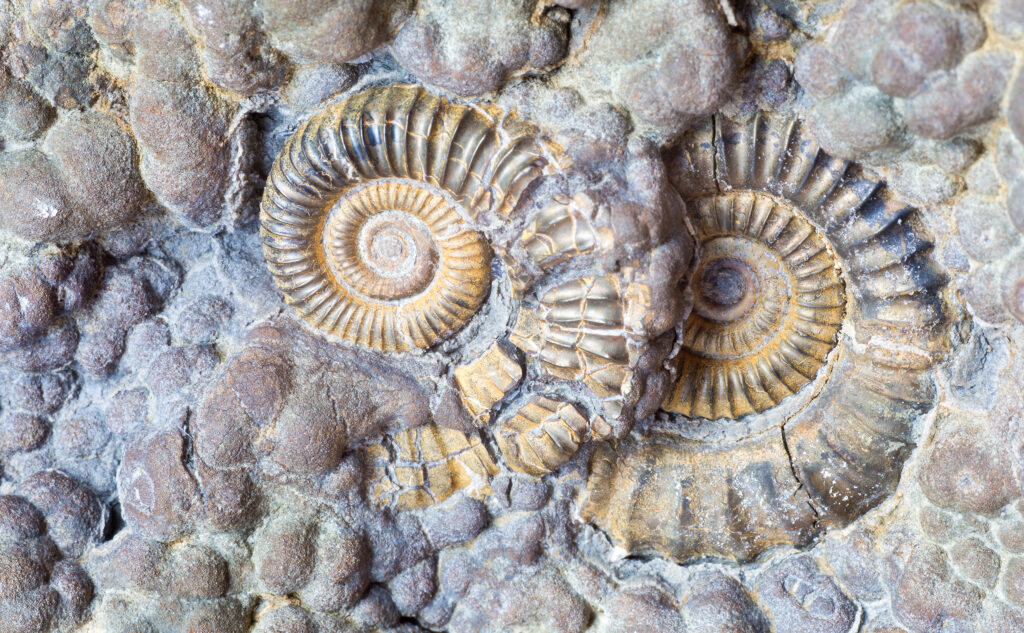
Ammonites: These distinctive spiral-shaped creatures are most commonly found fossils in Dorset. They’re the fossils of extinct shelled cephalopods (animals such as squids), which died out about 66 million years ago.
Belemnites: These small, bullet-shaped fossils are also very common, but can harder to spot. Again, they were squid-like animals with a shell, and usually it’s only the shell part which has been preserved.
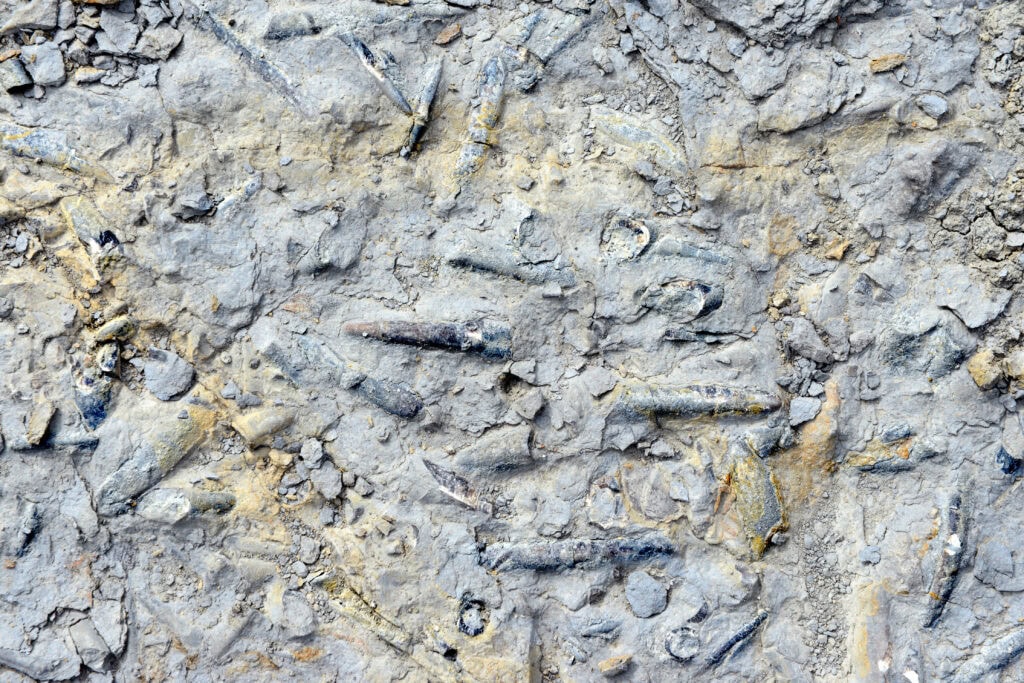
Bivalves and other shells: In Cretaceous rocks, you can find the fossilised remains of bivalves (aquatic molluscs like oysters), seashells, and – more rarely – lobsters.
Echinoids: Fossils of sea urchins which would have lived on the Cretaceous seafloor around 100 million years ago.
Coprolites: Fossilised animal poo! They’re fairly common, but difficult to identify. Read more here.
Ichthyosaur vertebrae: Occasionally, dinosaur bones are found on Dorset’s beaches. The most common are the vertebrae (back bones) of ichthyosaurs. These were large marine reptiles which thrived in the Early Jurassic period, approximately 200 million years ago.
Less common finds: Shark teeth, brachiopods, pliosaur, coral, and more.
Who Was Mary Anning?
Mary Anning was a pioneering fossil collector and palaeontologist born in 1799 in Lyme Regis. Despite limited formal education and the constraints of her gender and social class, she made groundbreaking discoveries that shaped early palaeontology. At just 12 years old, she unearthed the first correctly identified ichthyosaur skeleton. She also discovered the first complete plesiosaur and the first British pterosaur specimen.
Her fossil hunting revealed prehistoric marine reptiles that challenged scientific thinking and contributed to the emerging understanding of extinction and evolution. Though often overlooked by the scientific establishment of her time, Anning’s legacy endures. Today, visitors to Lyme Regis can explore her story at the local museum, which is built on the site of her former fossil shop.
Final Takeaways
Safety is very important when fossil hunting. Always check tide times and the weather forecast before heading out, and pay attention to any signs or warnings on the beaches. Stick to the foreshore and avoid the base of cliffs – and steer well clear of any recent rockfalls. And remember: no digging in the cliffs or hammering rocks.
If you find anything that you think might be of scientific interest along the West Dorset coast, you can share it with the Charmouth Heritage Centre. The fossil will still be yours to keep, but the centre keep a record of local findings in case they’re needed for study. Take a photo and try to take a note of exactly when and where you found it – then you can share your discovery with the Centre. Read more here.
Got a question about fossil hunting in Dorset? Scroll down to leave a comment!

